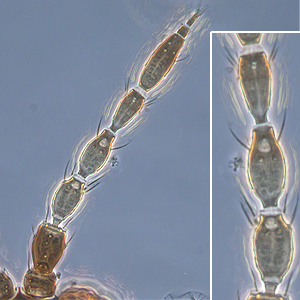Figures
Fig. 1: Antenna (inset: III. - V. antennal segment)
Fig. 2: Head dorsal with ocellar triangle
Fig. 3: Pronotum
Fig. 4: Meso- and metanotum
Fig. 5: Fore- and hindwing, base of fore wing with alula
Fig. 6: Sternites VI and VII
Fig. 7: Tergites V and VI
Fig. 8: Tergites VIII and IX
ITS-RFLP gel patterns (1&8 ladder, 2 PCR-product, 3 RSAI, 4 HaeIII, 5 MspI, 6 HinfI, 7 AluI)
Fig. 9: Primer pair P1/28Z
Fig. 10: Primer pair 18SMP/28SMP
Taxonomic Information
Species:
Tenothrips frici (Uzel, 1895)
Synonyms:
Taeniothrips (Tenothrips) alis Bhatti, 1967
Taeniothrips cibiniensis Knechtel, 1965
Taeniothrips persimilis Priesner, 1954
Taeniothrips adusta Knechtel, 1951
Taeniothrips fulva Knechtel, 1945
Taeniothrips pallidivestis Priesner, 1926
Taeniothrips alba Priesner, 1926
Physothrips blacki Watson, 1919
Physothrips brevicornis Bagnall, 1916
Euthrips dalmatica Karny, 1907
Euthrips pallidicornis Karny, 1907
Physopus frici Uzel, 1895
Common name:
Dandelion thrips
Present taxonomic position:
Family: Thripidae Stephens, 1829
Subfamily:
Thripinae (Stephens) Karny, 1921
Genus:
Tenothrips Bhatti, 1967
Species Recognition
General information about the genus Tenothrips:The 13 species in the genus Tenothrips are separated from the Taeniothrips, where they were once considered members, by the presence of three ocellar setae.
Typical character states of Tenothrips frici:
Body color
Mainly brown
Antennae
Number of antennal segments: 8
Segment IV - forked sensorium: scarcely extending beyond base of segment V
Segments II and III shape: more or less symmetric
Segments III & IV sensoria: emergent and forked
Base of sensorium on antennal segment VI: no more than 2 times as wide as base of nearest seta
Terminal antennal segments: rarely elongate
Head:
Distance between bases of ocellar setae III: greater than width of first ocellus
Head shape between compound eyes: not prolonged
Major postocular setae: less than half as long as ocellar setae III
Ocellar setae III on head: arising on anterior margin of, or in front of, ocellar triangle
Postocular setae I: present
Surface of head, pronotum and fore legs: without strong reticulate sculpture
Ocellar setae I in front of anterior ocellus: present
Prothorax
Number of pairs of elongate pronotal setae: 0-3
Number of pairs of elongate posteroangular pronotal setae: 2
Pronotum shape: rectangular
Number of pairs of pronotum posteromarginal minor setae: 3-5
Number of pairs of pronotum anteromarginal minor setae: 4
Mesothorax
Mesothoracic endofurca: with median spinula
Metathorax
Metanotal median area sculptured lines: transverse at anterior, but with irregular equiangular reticulation near posterior
Metanotal median setae length: longer than lateral metanotal setae
Metanotal median setae position: arising at anterior margin
Metanotum: with campaniform sensilla
Metanotum major sclerite: with two major sclerites, metascutum and metascutellum
Metanotum median area: with at least some or without equiangular reticulation
Metanotum sculpture: without dominant sculptured triangle medially
Metathoracic endofurca: transverse, sometimes with simple median spinula
Wings
Wings: present and more than half as long as abdomen
First vein of forewing: distinct from costal vein
Forewing anterior margin: with setae and cilia but cilia longer than setae
Forewing color: uniformly light brown
Forewing costal fringe of cilia: arising at anterior margin of wing
Forewing costal setae at middle of wing: shorter than median width of wing
Forewing first vein setal row: incomplete, with setae not closely and uniformly spaced
Forewing posterior margin cilia: undulated near apex
Forewing second vein setal row: complete, with setae closely and uniformly spaced
Forewing surface: not reticulate
Forewings: with veins, setae and microtrichia
Legs
Fore tibial apex: not extending around fore tarsus
Mid and hind tarsi: with two segments
Abdomen:
Pleurotergal discal setae: absent
Abdominal pleurotergites: not covered in microtrichia
Abdominal segment X: never tubular, longitudinally incomplete ventrally in both sexes
Abdominal sternite II: with marginal setae but no discal setae
Abdominal sternite III of female: without glandular areas
Abdominal sternite VII: with marginal setae but no discal setae
Abdominal sternite VII median marginal setae: arising in front of margin
Abdominal sternites IV , V and VI: with marginal setae but no discal setae
Number of lateral marginal setae on abdominal tergite II: 3
Abdominal tergites: without curved wing-retaining setae
Abdominal tergites IV & V median setal pair: much shorter than distance between their bases
Abdominal tergites V-VII: without paired ctenidia, sometimes with irregular microtrichia
Setae on abdominal tergite X: slender
Surface of lateral thirds of abdominal tergites: without regular rows of fine microtrichia
Ctenidia on tergite VIII: not present, but groups of microtrichia
Tergite VIII posteromarginal comb of microtrichia: present laterally, incomplete medially
Tergite VIII posteromarginal microtrichia: short on broadly triangular bases
Biology
Life history:
As with other thrips species the life cycle from egg to adult is dependent on temperature. The full cycle can take about 15 days (Lewis, 1973) to over a month and adults may live for more than one month producing several generations in one year depending on seasonal weather. With greenhouse temperatures the developmental time from egg to adult can decrease to about one week.
Host plants:
Asteracea
Vector capacity:
None identified
Current known distribution:
Africa, Asia, Australia, New Zealand, Central and South America, Europe, North America
Additional notes:
This species is readily found breeding in the flowers of numerous Asteracea.
Bibliography
Lewis, T (1973): Thrips their biology, ecology and economic
importance. Academic Press Inc., London Ltd. 349 pp.
Moritz G, Morris DC, Mound LA (2001): ThripsID -
Pest thrips of the world. ACIAR
and CSIRO Publishing Collingwood, Victoria, Australia, CDROM ISBN 1 86320
296 X.
Moritz G, Mound LA, Morris DC, Goldarazena A (2004): Pest
thrips of the world - an identification and information system using molecular
and microscopial methods. CBIT, University of Queensland,CDROM ISBN 1-86499-781-8.
Mound, LA & Marullo, R (1996): The
thrips of Central and South America: An Introduction (Insecta: Thysanoptera).
Associated Publishers, Gainesville.
Wilson, CR (1998): Incidence of weed reservoirs and vectors
of tomato spotted wilt tospovirus on southern Tasmanian lettuce farms. -
Plant Pathology 47 (2): 171-176.
Zawirska, I (1988): Ceratothrips frici (UZEL) and Ceratothrips
reichardti (JOHN) - A comparison of morphology. Acta Phytopathologica
et Entomologica Hungarica, 23, 373-384.
Links:
Mound, LA (2005): Thysanoptera (Thrips) of the World
- A Checklist. http://www.ento.csiro.au/thysanoptera/worldthrips.html











